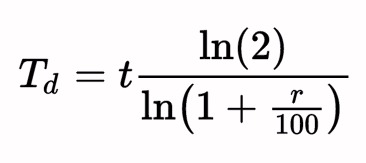
By Daniel Brouse and Sidd Mukherjee
August 25, 2023
Update: 2025
When we began our experiments in the 1990s, we believed the time scale for significant climate change was measured in millennia. If climate change progressed linearly, that assumption would hold. However, by the late ’90s, our findings revealed a non-linear pattern of change. Climate impacts were accelerating exponentially, not gradually.
Doubling time--the period required for a quantity to double--is a key feature of exponential growth. By 2020, data showed the doubling time for certain anthropogenic climate impacts had dropped dramatically, from 100 years to just 10 years. For instance, sea level rise increased from about 1.5 mm/year to over 3 mm/year. If this trend continues, we could be facing sea level increases of one foot per year by 2050.

| = | doubling time | |
| = | time | |
| = | growth rate |
Extreme weather events are also intensifying and becoming more frequent. A rule-of-thumb derived from the 2023 Canada wildfires illustrates this:
These multipliers likely extend to hurricanes, droughts, heatwaves, atmospheric rivers, and sea-level-related flooding.
If the doubling time remains at 10 years, within the next decade, extreme events could be twice as intense and 14 times more likely. Should doubling time shrink to 5 years, by 2034 we may see 200% intensity with a 28x increase in occurrence.
According to NASA, global average sea level rose by approximately 0.3 inches (0.76 cm) from 2022 to 2023. When we first wrote this paper in 2023, we foresaw a 10-year doubling period. Shockingly, new observations suggest a further contraction of the doubling period to just 2 years.
Sidd commented, “I suspect this is linked to the large jump in sea surface temperature last year, perhaps because of the restriction on sulfur in marine fuel. The top of the ocean warmed quickly and expanded. Let’s see if it is sustained.”
Indeed, 2023 was not only the hottest year on record overall but also the warmest for global oceans. A study in Advances in Atmospheric Sciences found that the upper 2,000 meters of the ocean gained 15 zettajoules more heat in 2023 than in 2022. This thermal expansion accounts for roughly half of all sea-level rise.
Answer: Far more rapidly than anticipated.
In summer 2023, earth's surface temperatures averaged over 3°C above pre-industrial levels--double the Paris Agreement's 1.5°C ceiling. Scientists agree that a 2°C rise will trigger tipping points and feedback loops. Once triggered, carbon stored in permafrost, forests, and other reservoirs is released, further intensifying warming. This chain reaction--dubbed the “Domino Effect”--reduces doubling time even more and could push temperatures from 3°C to 6°C above pre-industrial levels.
Humans cannot thrive at 1.5°C above pre-industrial temperatures. At 6°C, human survival itself becomes unlikely.
Hawaii Governor Josh Green:
“We’ve had six fire emergencies this August alone--equal to the number we had from 1953 to 2003. That’s how fast things are changing. Climate change is here. We are in the midst of it--with a hotter planet and fiercer storms.”
Dr. Caroline Holmes, British Antarctic Survey:
“What we’re seeing right now is so far outside what we’ve observed previously. We expected change, but not this much, and not this fast.”
Jeff Boyne, National Weather Service Climatologist:
“The planet is warming so fast that climate normals now require updating every 10 to 15 years--ENSO regions every 5 years.”
Walter Meier, National Snow and Ice Data Center:
“It’s so far outside anything we’ve seen, it’s almost mind-blowing.”
Zeke Hausfather, Berkeley Earth:
“September was, in my professional opinion as a climate scientist, absolutely gobsmackingly bananas.”
Dr. James E. Hansen's recent paper Global Warming Acceleration: Impact on Sea Ice confirms our theory. His analysis shows that climate sensitivity is far higher than IPCC projections and that existing models underestimate key feedbacks. At current emissions levels, Hansen warns warming could reach or exceed 7°C by 2100, drastically increasing the risk of crossing irreversible tipping points.
The rate of climate change acceleration is no longer a question--it is a reality. With sea level rise, extreme weather, and temperature anomalies all growing exponentially, urgent action is required. Mitigating feedback loops and preventing cascading tipping points must become immediate global priorities if we are to preserve a habitable planet.
URGENT CLIMATE WARNING
Our latest climate model — now incorporating complex social-ecological feedback loops within a dynamic, non-linear system — projects that global temperatures could rise by up to 9°C (16.2°F) within this century. This far exceeds earlier estimates, which predicted a 4°C rise over the next thousand years, and signals a dramatic acceleration of warming.
At this level of heating, large regions of the planet will become uninhabitable due to extreme heat, sea level rise, agricultural collapse, and mass migration. Critically, parts of the U.S. are already experiencing wet-bulb temperatures approaching or exceeding 31°C (87.8°F) — a physiological limit beyond which the human body can no longer regulate its internal temperature, even in the shade with ample water.
This is no longer a distant threat. The climate system is entering a phase of compound risk and cascading collapse — and we are already seeing the early signs.
Immediate, radical mitigation and adaptation efforts are now essential to preserve habitable zones, food systems, and public health.
The Philadelphia Spirit Experiment Publishing Company